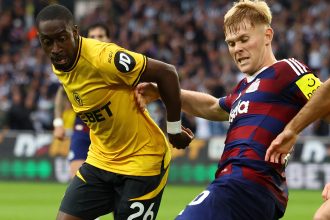Major League Soccer rules have ensured that its league remains unpredictable, but equality might be limiting growth
It's June 2025. Lebron James and Luka Doncic have just dethroned the Boston Celtics in the NBA Finals. Lebron has averaged 30, seven and seven. Doncic scores 25, puts up three triple doubles and hits the game winner at the buzzer to seal what might be James' final NBA title.
And then … Lakers General Manager Rob Pelinka is forced to blow up the whole thing. Lebron goes. So do a number of key role players. The locker room is, more or less, barren. The Lakers have to overpay to rebuild, and bring in a handful of agreeable yet inferior replacements. They start the next season slowly, and watch as their title defense falls apart within a month.
Sound far-fetched?
That is more or less what has happened to the LA Galaxy this season. They were excellent last year. And despite the fact that Inter Miami set a new MLS points record, it was the Los Angeles side who were most well-balanced, and best positioned to win. That proved to be the case, Greg Vanney's side comfortably navigating the playoffs and winning their first MLS Cup in 10 years.
But rather than be rewarded for their success, the Galaxy have had to restructure their roster, trade away key pieces, and are struggling as a result – winless through five games, minus-six goal differential, sitting 14th in the Western Conference. Indeed, their shortcomings this year can be partially attributed to a restrictive system, one that has not only dampened one club's title defense but also speaks to a larger problem of continuity within the league that perhaps limits its global appeal.
IMAGNA broken offseason
First, a review of the Galaxy's transfer moves. Since lifting MLS Cup, the Los Angeles side have been forced to, effectively, disassemble their roster. Gone is star striker Dejan Joveljic – sent to Sporting KC for $4 million despite the team's reluctance to let him leave. Crucial midfield piece Mark Delgado has left. Gaston Brugman, MLS Cup MVP, was traded to Nashville.
Factor in an ACL tear suffered by Riqui Puig in last year's western conference finals, and the title winners are down three key pieces from a title winning side. It is something of a miracle, meanwhile, that they managed to hold on to MLS Newcomer of the Year Gabriel Pec, who proved himself worthy of a European move on the back of an impressive rookie season.
Their incomings? A slew of low-budget but necessary moves that don't jump off the page. Matheus Nascimento, a young Brazilian forward, has been brought in on loan from Botafago. He looks a fine player who could have an impact, but is admittedly raw. Christian Ramirez, from Columbus Crew, arrived for a meager $250,000. He might yet be an impact striker, but he is also 33, and has hit double digit goals in MLS just once.
And this isn't just a run of poor luck or mismanagement. In fact, Taylor Twellman, former MLS MVP and now Apple TV analyst, saw this all coming.
"What happens in MLS with your salary cap and how it works is when you're successful, more often than not, your players have bonuses that roll into the salary cap, and it makes it a little difficult to navigate that," he told GOAL. "And you've seen some of those moves with [Dejan] Joveljic and [Gaston] Brugman – I think that's going to be interesting."
AdvertisementGetty Images SportPlaying by the rules
Piece it all together, and LA are markedly weaker than the side that won MLS Cup last year. And they don't really have a choice, either. For all of the good vibes about the league brought about by Lionel Messi's arrival in MLS, the salary cap rules remain immensely restrictive.
And they really are far more complicated than they should be. The total roster size in MLS is 31. As of 2025, the MLS salary cap is $5.95 million. That would seem financially improbable for professional athletes. And it is.
So, MLS has elected to make things tricky. The first 20 players on the roster, if used – some clubs will only employ 18 – have to fit under that number. The maximum allowance is $743,750. Simple enough so far. There are further rules here for homegrown products, Generation Adidas signees, minimum contracts, as well as players under 24. Most teams are able to check all of those boxes.
Outside of the standard salary cap, MLS has allowed something resembling flexibility. There are six additional roster spots that exist outside of salary cap rules that allow for freer spending. Clubs can elect to tag three players as "designated players" and three as part of an under-22 initiative, or tag two as "designated players" and four under 22s, and also receive $2 million in extra money on the side. It's how LAFC managed to spend so much on Olivier Giroud, and Toronto FC shelled out big for Lorenzo Insigne.
Got all that? And this is where it gets really complicated. Clubs are also allowed two other types of cash: General Allocation Money (GAM) and Targeted Allocation Money (TAM.) GAM is an annual allotment given by MLS that owners can spend to adjust the salaries of designated players and work around restrictions. In 2025, it totals just under $3 million, and can be traded by clubs (according to information released by the league earlier this month, LA have exactly $0 left to spend.) TAM does much of the same, and cannot be traded between teams.
Confused yet? This is all needlessly tricky.
ImagnWhy the rules exist
This isn't necessarily intentionally designed to constrict teams. In abstract, the rules were shrewd moves that protected clubs as MLS expanded. Don Garber has overseen immense growth as MLS commissioner, but, in turn was forced to limit overspending, and ensure that clubs control their finances.
Reckless financial mismanagement could have brought about significant issues. These are protective measures. There is also the fact that MLS owners don't necessarily have the same financial power as European clubs. Getting them to spend big, in the early days, was far more difficult. It wasn't until David Beckham's arrival in 2007 that restrictions were loosened.
It is also worth pointing out that the league has made strides in steadily changing things. The new cash-for-player rule, which allows teams to trade players for unlimited money, has brought about movement around the league. The likes of Evander, Lucho Acosta and Jack McGlynn were all facilitated by the initiative.
"Probably the biggest innovation we’ve had has been cash trades within the league," Garber told Sports Business Journal before the start of the season. "Think of it almost as an internal transfer market, which is something that’s new. We had Jack McGlynn as the best example of that."
Garber admitted, too, that it might be time for the salary cap to be lifted – even if it has some clear benefits.
"In terms of governance, we'd probably change things: maybe not have strict salary caps, maybe not have a centralized entity like the league office making a lot of learned decisions based on committees and the like," Garber said. "But I think we have a model that has driven our success, and I think if that model was adapted around the world, football would be in much, much better shape."
Getty ImagesWorking outside of the global sphere
This, in isolation, wouldn't necessarily be problematic. After all, parity is, objectively, a good thing. It breeds competition and brings about unpredictability. In theory, when everyone is at a roughly equal level, then anyone can win this thing on any given year. Storylines are rife, and chaos tends to ensue. Apple TV analyst Kaylyn Kyle has asserted that it might be the league's greatest strength.
"It's one of the most exciting [leagues], because you genuinely don't know who's going to win every single weekend. Whereas when you're you're looking at the Prem, you're looking at La Liga, you have those top, top, top teams that seem to get the job done," Kyle told GOAL.
But is that really what fans want? Part of the appeal of global soccer, in particular, is that there are both dynasties and perennial strugglers. It's what gives fans something to root for – or against. Manchester City, love them or hate them, have captured the imagination worldwide for their dominance of the Premier League. A lot of their fans may live outside of the Northwest of England, but their rise – and subsequent struggles – is a fascinating storyline.
Going further back, their cross-city rivals, Manchester United, have undergone a similar thing. Under Sir Alex Ferguson, they were the dynasty that pretty much everyone else loved to hate. Yes, Arsenal and Chelsea occasionally broke into the picture, but their dominance of English football made the Premier League one of the most watchable and captivating things every year.
It also bred a worldwide fan base. Right or wrong, there are a whole generation of supporters who consider themselves United fans based on prior success. The same can be said for Barcelona and Real Madrid in La Liga, as well as Bayern Munich in the Bundesliga. And when those teams do fall out of favor – United's struggles since Ferguson retired have been particularly amusing for some – then it only gets more interesting. "Hate watches" as the cool kids call them, can bring eyes, too.
More broadly, it leads to a sense of brand building. These clubs are built on stars and success. They are good at what they do, and have the big names to latch onto. Don't know who to root for as a casual fan? Chances are, your eyes latch onto the team with the most bursting trophy cabinet or best players.






